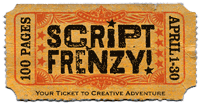|
Script Frenzy
 Script Frenzy, also known as Screnzy /ˈskrɛn.ziː/, was an international screenwriting challenge where participants attempted to write a script (for the stage, screen, or other media) during the month of April. The event was organized by The Office of Letters and Light, the nonprofit organization behind National Novel Writing Month ("NaNoWriMo"). It ran each year from 2007 until 2012. Original format, and developmentsThe first Script Frenzy was held in June 2007 with a goal of 20,000 words to win. In 2008, Script Frenzy was moved to April and the goal was changed to 100 pages. The goals are roughly equivalent; the change simply reflects the fact that page count is a more standard measure of script length. Other changes include the ability for writers to team up and work as two-person teams. The functionality was given to link both writers such that their page count would be shared. Finally, in the original Script Frenzy only screenplays and stage plays were permitted. This has been expanded to include other types of scripts including TV series, graphic novels, shorts and audio plays amongst others. For the shorter formats, participants were allowed to submit several scripts to make up the 100-page total. Closure of the eventOn June 26, 2012, it was announced that Script Frenzy was being closed down. The decision was made by the Office of Letters and Lights board after close consideration and a vote. The event was cancelled due to a continued decline in participants and, likewise, a continued decline in donations.[1] StatisticsAdult Program Statistics:
Young Writers Program Statistics:
RulesThe 5 Basic Rules of Script Frenzy are as follows:[2]
See alsoScript Frenzy is the script version of National Novel Writing Month, better-known as NaNoWriMo, where participants use November's 30 days to try to write 50,000 words of prose (a short novel, or series of short stories, or part of a longer novel). NaNoWriMo was started in July 1999 by Chris Baty, and garnered a mere 21 participants. In 2000, the challenge moved to November, and by 2009, the event had 170,000 participants. References
External links |